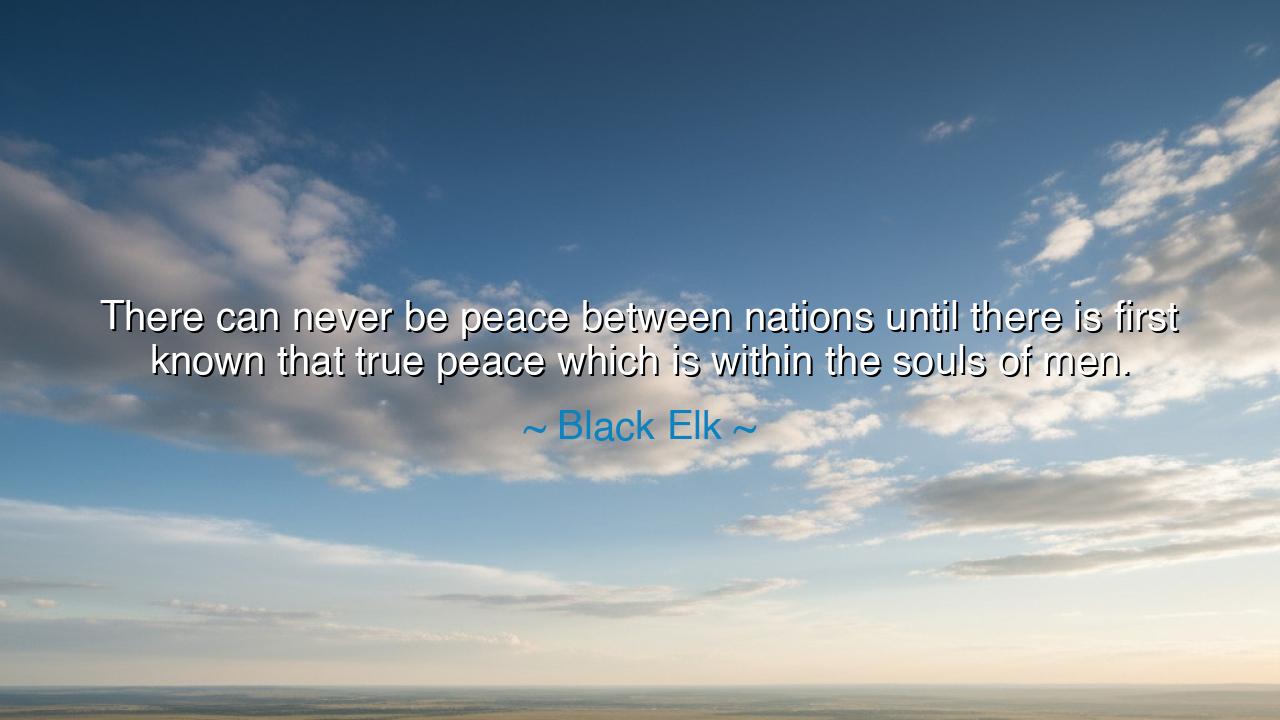
There can never be peace between nations until there is first
There can never be peace between nations until there is first known that true peace which is within the souls of men.






In the depths of the human spirit, there lies a truth so profound and so simple that it transcends the barriers of time, culture, and conflict. Black Elk, a great Lakota spiritual leader, once spoke these words: “There can never be peace between nations until there is first known that true peace which is within the souls of men.” These words are not merely a plea for world peace, but a call to the very essence of what it means to be human. They remind us that the external wars we fight—be they between nations, tribes, or ideologies—are but reflections of the internal battles we wage within ourselves. True peace, as Black Elk teaches, is not a treaty signed by leaders, but a harmony felt in the deepest recesses of the soul.
The ancients understood this truth in ways that speak to the core of human experience. Socrates, the philosopher, often spoke of the unexamined life, urging that peace cannot be achieved without first achieving inner harmony. For Socrates, the pursuit of wisdom was not just an intellectual exercise; it was a spiritual journey, a way of seeking balance and truth within oneself. Similarly, the Stoics, like Marcus Aurelius, taught that the peace one sought in the world could only be achieved when the soul itself was at peace. Aurelius reflected that external circumstances, no matter how turbulent, cannot disturb the mind of the wise person who has learned to cultivate inner peace. This internal equilibrium, the Stoics believed, was the foundation of all external peace.
Black Elk, with his profound wisdom rooted in the spiritual traditions of his people, brings us back to this ancient insight. His words point us to the importance of reconciliation within the individual before there can be reconciliation in the world. As long as men are at war within their own hearts, as long as they are driven by fear, anger, and greed, how can we expect nations to be free from these same forces? The battles we wage against one another are born from the conflicts we experience within ourselves. As the ancient Chinese philosopher Lao Tzu said, “If there is to be peace in the world, there must first be peace in the heart.” It is in this inner peace that the foundation for a peaceful world is laid.
Consider the story of Gandhi, whose nonviolent resistance to British colonial rule in India was founded not on force, but on the belief that true freedom comes from inner peace. Gandhi’s commitment to ahimsa (nonviolence) was not merely a political strategy; it was a spiritual discipline that sought to transform the hearts and minds of individuals before it sought to change the structures of society. Gandhi understood that a nation cannot be free if its people are shackled by inner conflict. His teachings, much like Black Elk’s, show us that the first step toward world peace begins with peace in the heart of each individual. Gandhi’s personal quest for peace and truth was not just a path to national liberation; it was a path to the liberation of the soul.
The message that Black Elk imparts is one of profound self-awareness. Before we can ask for peace in the world, we must first ask ourselves: “Am I at peace within?” This question echoes through the stories of the ancient warriors—those who, though they fought great battles, sought a warrior’s peace through balance and mindfulness. Tecumseh, the great Shawnee leader, often spoke of the necessity of spiritual balance before the physical. He understood that the heart of a warrior must be calm, that one must seek wisdom and composure before engaging in battle. In this, we see a clear line connecting the quest for inner peace with the outward expressions of courage and action. To truly fight for peace in the world, one must first battle within oneself.
The true lesson here is not merely to seek peace in the world, but to recognize that peace can never be truly attained until it is found within each of us. The inner peace that Black Elk speaks of is a state of reconciliation within the soul—where the divisions within the self are healed, where anger, fear, and desire no longer dominate. This peace does not come from suppressing our emotions, but from understanding them, from forgiving ourselves, and from learning to live in harmony with the world as it is, rather than how we would wish it to be.
So, let us take Black Elk’s wisdom to heart: if we seek peace in the world, we must first cultivate peace within ourselves. We must look deeply into our own souls and ask whether we are at war with ourselves—whether we harbor resentments, fears, or judgments that hold us back from true harmony. Only when we find that peace within our own hearts can we begin to build a peaceful world around us. Just as the ancients taught, let us remember that true peace is not a state to be achieved by force, but by understanding, acceptance, and reconciliation within the self. The journey to peace is not an external one, but an internal one, where each step taken toward healing ourselves brings us closer to healing the world.






AAdministratorAdministrator
Welcome, honored guests. Please leave a comment, we will respond soon